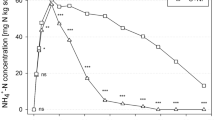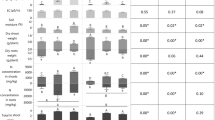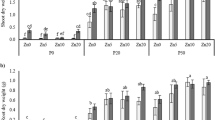Abstract
IT has been widely assumed that the translocation of nutrient ions to plant shoots occurs chiefly from young extending zones of tissue within 1 cm of the apical meri-stems of roots. The rapid accumulation of ions which can occur in this zone1–3, its high metabolic activity4–7 and the fact that considerable thickening of the endodermis seems to create a barrier to the entry of ions into the stele4,8 have been regarded as evidence for this. Results of more recent studies have indicated, however, that translocation occurs to an approximately constant extent over the apical 6 cm of cereal roots9,10 despite the progressive development of the endodermis8. These findings encourage the study of nutrient absorption and translocation by older parts of the root axis. Information on this question is relevant both to the elucidation of the effects of the structure of roots on their capacity to absorb ions, and to the assessment of the limitations which the rate of ionic diffusion in soil11,12 may impose on plant nutrition.
This is a preview of subscription content, access via your institution
Access options
Subscribe to this journal
Receive 51 print issues and online access
$199.00 per year
only $3.90 per issue
Buy this article
- Purchase on Springer Link
- Instant access to full article PDF
Prices may be subject to local taxes which are calculated during checkout
Similar content being viewed by others
References
Steward, F. C., and Sutcliffe, J. F., Plant Physiology, 2, 454 (Academic Press, NY, 1959).
Bowen, G. D., and Rovira, A. D., Austral. J. Biol. Sci., 20, 369 (1967).
Rovira, A. D., and Bowen, G. D., Nature, 218, 685 (1968).
Steward, F. C., Prevot, P., and Harrison, J. A., Plant Physiol., Lancaster, 17, 411 (1942).
Berry, J. E., and Norris, Jun., W. E., Biochim. Biophys. Acta, 3, 593 (1949).
Brown, R., and Broadbent, D., J. Exp. Bot., 1, 249 (1951).
Lund, H. A., Vatter, A. E., and Hanson, J. B., J. Biophys. Biochem. Cytol., 4, 87 (1958).
Van Fleet, D. S., Bot. Rev., 27, 165 (1961).
Wiebe, H. H., and Kramer, P. J., Plant Physiol., Lancaster, 29, 342 (1954).
Russell, R. S., and Sanderson, J., J. Exp. Bot., 18, 491 (1967).
Lewis, D. G., and Quirk, J. P., Nature, 205, 765 (1965).
Nye, P. M., Pl. Soil, 25, 81 (1966).
Russell, R. S., and Squire, H. M., J. Exp. Bot., 9, 262 (1958).
Appleton, T. C., J. Roy. Microsc. Soc., 83, 277 (1959).
Crossett, R. N., Nature, 213, 312 (1967).
Rogers, A. W., Techniques of Autoradiography (Elsevier, Amsterdam, 1967).
Barber, D. A., Sanderson, J., and Russell, R. S., Nature, 217, 644 (1968).
Clarkson, D. T., and Sanderson, J., Agricultural Research Council Radiobiological Laboratory Report ARCRL, 18, 30 (1968).
Bryant, A. E., New Phytol., 33, 231 (1934).
Biddulph, S. F., Planta, 74, 350 (1967).
Author information
Authors and Affiliations
Rights and permissions
About this article
Cite this article
CLARKSON, D., SANDERSON, J. & RUSSELL, R. Ion Uptake and Root Age. Nature 220, 805–806 (1968). https://doi.org/10.1038/220805a0
Received:
Issue Date:
DOI: https://doi.org/10.1038/220805a0
This article is cited by
-
Diffusible repression of cytokinin signalling produces endodermal symmetry and passage cells
Nature (2018)
-
Root Endodermis and Exodermis: Structure, Function, and Responses to the Environment
Journal of Plant Growth Regulation (2002)
-
Beyond the Roots of Young Seedlings: The Influence of Age and Order on Fine Root Physiology
Journal of Plant Growth Regulation (2002)
-
Fall in nutrient demand per unit root length during the linear phase of plant growth
Plant and Soil (1994)
-
Uptake of phosphate from soils and fertilizers as affected by soil P availability and solubility of phosphorus fertilizers
Plant and Soil (1990)
Comments
By submitting a comment you agree to abide by our Terms and Community Guidelines. If you find something abusive or that does not comply with our terms or guidelines please flag it as inappropriate.



